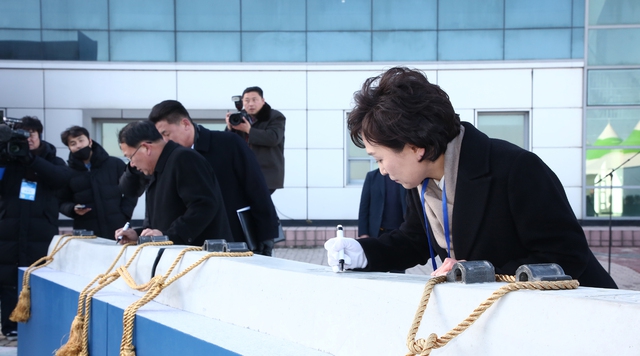Posted on : Dec.31,2018 11:50 KST
 |
|
The groundbreaking ceremony for linking South and North Korean railway networks is held at Panmun Station in Kaesong, North Korea, on Dec. 26. (photo pool)
|
The groundbreaking ceremony for a project to modernize North Korea’s roads and railways and link them to the South Korean network was held at Panmun Station in the North Korean city of Kaesong on Dec. 26. It is very significant that South and North Korea kept the promise they made in the Pyongyang Joint Declaration in September to hold the ceremony before the end of the year, following the agreement to connect the Gyeongui (Seoul-Sinuiju) and East Sea lines in the Panmunjom Declaration on Apr. 27. By overcoming the obstacles presented by sanctions on North Korea to hold the ceremony, the two sides have further reinforced mutual trust.
The groundbreaking ceremony can be regarded as symbolizing the efforts to bring South and North Korea, who have been going down separate roads for nearly 70 years, onto the same path. This is the first step toward prosperity and synergy between South and North Korea, and it is a major contribution to establishing permanent peace on the Korean Peninsula. Another reason that this groundbreaking is significant is that it represents a turning point toward enabling the southern half of the Korean Peninsula, which was rendered a virtual island by the peninsula’s division, to be directly reconnected with the Asian continent.
 |
|
South Korean Minister of Land, Infrastructure and Transport Kim Hyun-mi and Deputy Minister Kim Yoon-hyuk of North Korea‘s state railway during a signing ceremony for the the linking of South and North Korean railways on Dec. 26. (photo pool)
|
Another historical milestone was the large number of senior officials from both South and North Korea who expressed their commitment to cooperation by attending the groundbreaking. What is even more notable is the figures from international bodies and related countries who attended the groundbreaking at the invitation of the South Korean government, including railroad officials from China, Russia and Mongolia. The groundbreaking can be taken as an announcement to the entire world that this goes beyond simply connecting the South and North Korean railway networks; rather, it is part of an ambitious plan to link them to the Trans-Siberian Railway and China’s national rail network, thus creating a railroad community in Northeast Asia.
South Korean President Moon Jae-in unveiled the plan for the Northeast Asian railroad community in his congratulatory address for Liberation Day on Aug. 15. We look forward to the day that this plan achieves meaningful results in inter-Korean cooperation and the Korean Peninsula becomes a nexus of the Northeast Asian economic network.
Connecting the South and North Korean road and railway networks is expected to contribute in no small way to revitalizing the South Korean economy, where growth has stalled. The Gyeongui Line by itself, experts project, will bring 140 trillion won (US$125.23 billion) worth of economic benefits over the next 30 years. That represents savings on logistics costs and imports of North Korea’s underground resources.
But this project still has a long way to go. Although a joint team of South and North Koreans recently surveyed the conditions on the North Korean rail lines, a more thorough survey will be necessary moving forward. It will also take time to complete the roadmap for inter-Korean cooperation on roads and railways. The government needs to make thorough preparations now to ensure that the road and railway connection project can proceed without any hitches.
The key requirement for this project to move forward is making progress on the denuclearization of the Korean Peninsula and easing sanctions on North Korea. The denuclearization talks between North Korea and the US have been deadlocked for several months now. Fortunately, there have been signs that this impasse may end after US Special Representative for North Korea Stephen Biegun visited South Korea last week. Our hopes have been increased by US President Donald Trump’s “Christmas message” in which he said he looks forward to seeing North Korean leader Kim Jong-un again.
The strategic report about North Korea that was published recently by the US State Department divides the denuclearization issue into the short term and long term, which is an encouraging indication of a pragmatic approach. It is no exaggeration to say that inter-Korean cooperation has run along at the pace of progress in the North Korea-US denuclearization negotiations. We hope that the groundbreaking ceremony will provide momentum for those negotiations.
Please direct comments or questions to [english@hani.co.kr]










